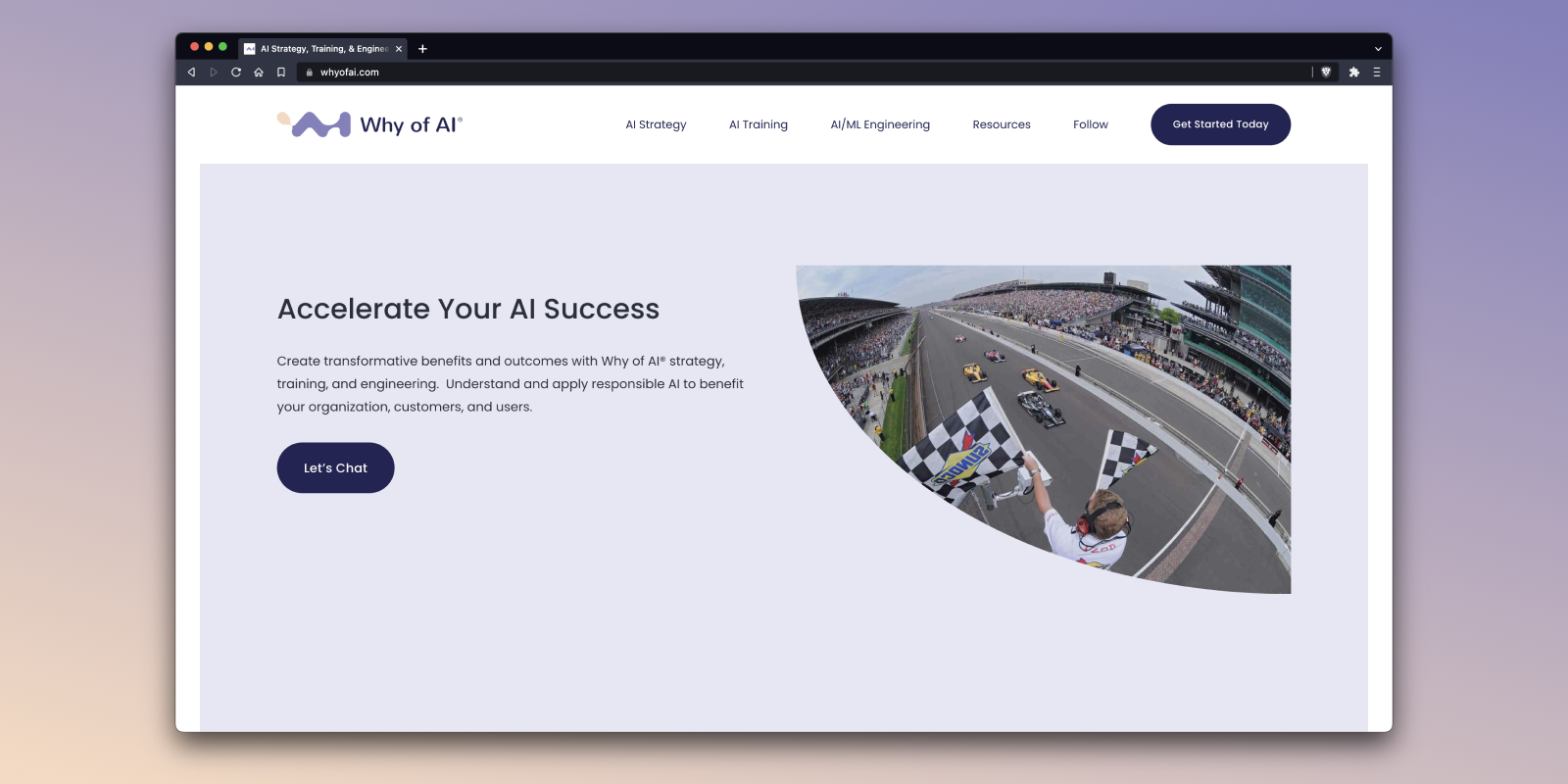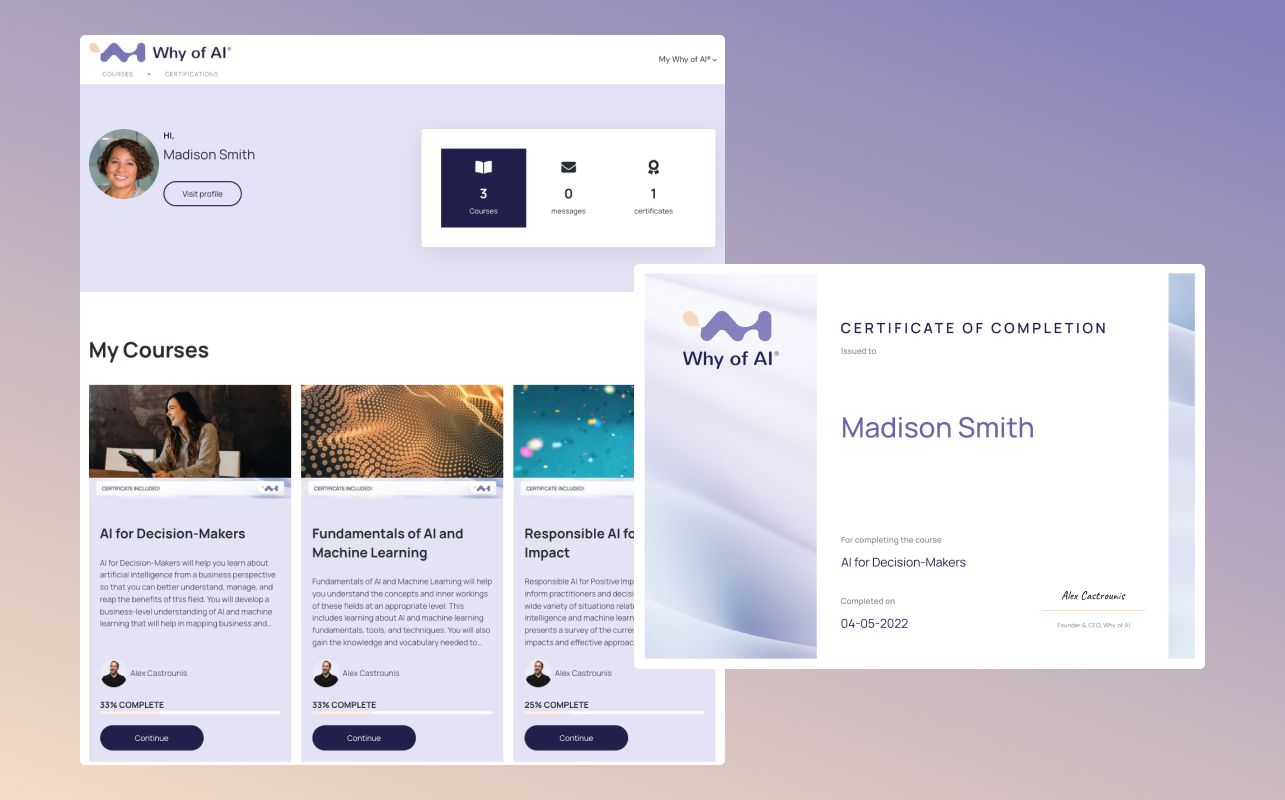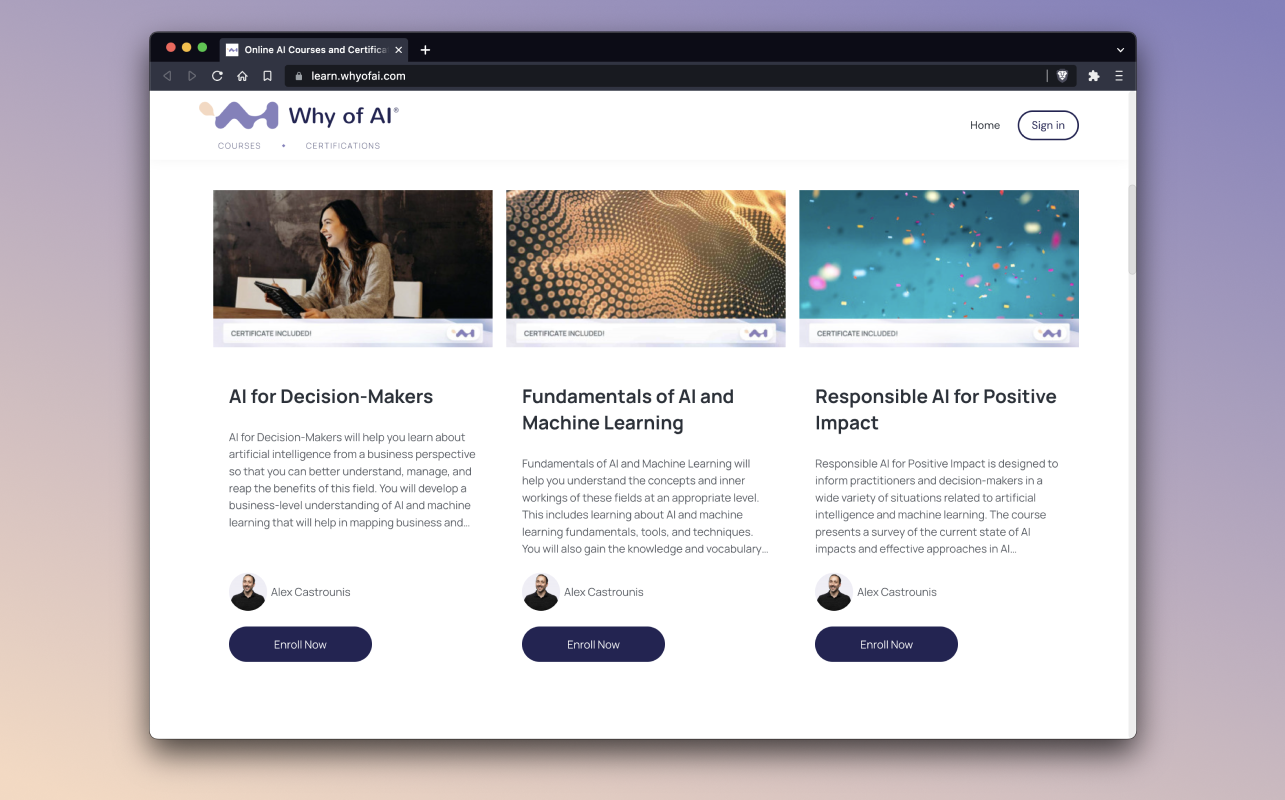Alex Castrounis is the founder and CEO of Why of AI and the author of AI for People and Business. He is also an adjunct for Northwestern University’s Kellogg / McCormick MBAi program, where he created and teaches the program’s core AI and machine learning course.
In addition to being a former INDYCAR Engineer, Race Strategist, and Data Scientist, Alex has spent the last two decades advising businesses of all sizes, from startups to Fortune 100s, on how to use data, analytics, and technology to drive business and customer success.
We were excited to be able to sit down with Alex and talk about his extensive experience teaching AI via his online courses, in-person workshops, and the Northwestern University MBAi program.
Let’s dive in!
Paperspace. Thanks so much for speaking with us today. We know that you’ve been teaching machine learning and AI more broadly for some amount of time to people at different points in their learning journey. What do you know now about teaching AI that you wish you knew when you started?
Castrounis. Great question! This is one of the reasons that my company is named Why of AI! For example: Why does AI exist? Why is AI important? Why is AI beneficial and/or potentially harmful? Why do companies need to learn more about AI and apply it responsibly? Why do individuals need to gain AI literacy and fluency? And so on.
Properly answering these questions is critical to creating a successful and responsible AI vision and strategy no matter who you are or what background you have.
A lot of AI and machine learning education out there is very technical and geared towards practitioners, so as a result is mostly focused on the WHAT and the HOW. One of my primary goals in teaching is to focus heavily on the WHY to help people understand the way these technologies can be applied to real-world problems, use cases, and applications in specific industries and business functions.
For the audience that I typically teach, this tends to be much more important than the deep technical details around machine learning algorithms, modeling techniques, and other related technical topics.

Paperspace. What are some of your favorite teaching materials for AI that are out there that are not your own? Do you have special appreciation for how some other folks are teaching machine learning?
Castrounis. I create the majority of my teaching materials, although I definitely have some favorites that are not my own.
For those that want to do hands-on AI/ML development work, I’m a big believer in learning directly from API docs. This might include languages, libraries, frameworks, and platforms. I think there’s no better way to learn than to dive right in and get your hands dirty, and especially to learn how to read, understand, and implement working solutions directly from official documentation.
For research and updates on the latest and greatest in AI and machine learning – arXiv and Papers with Code are great resources. I also really like the State of AI Report by Nathan Benaich and Ian Hogarth, and the AI Index Report from the Stanford Institute for Human-Centered Artificial Intelligence (HAI).
There are some great interactive AI and machine learning tools that help demonstrate what these technologies can actually do. Write with Transformer and the OpenAI API are great examples, although there are many others as well.
As far as appreciation for how other folks are teaching machine learning, I really like Two Minute Papers and many of the great machine learning visualizations created by Jay Alammar.

Paperspace. What would you recommend to someone learning machine learning for the first time? What kind of advice is helpful to someone who is just starting out?
Castrounis. It really depends on what your goals with machine learning are. If you’re learning with the goal of becoming a data scientist, machine learning engineer, or a related role, I’d recommend learning a programming language like Python alongside a widely used IDE like Jupyter Notebooks. From there, I’d recommend you start playing around with popular tools such as Pandas, Scikit-learn, PyTorch, Hugging Face, and so on.
I’d also highly recommend figuring out what areas of machine learning are of highest interest to you, and let that be a guide. Machine learning is a vast field that spans many areas such as predictive analytics, personalization, recommender systems, computer vision, natural language (NLP, NLG, NLU), conversational AI, etc. Rather than try to learn everything at once, I’d recommend choosing a sub-area of machine learning that is most interesting, and learn how to work with the relevant data, tools, and tasks in that area.
For those interested in learning more about machine learning for business and decision-making purposes, I’d recommend getting familiar with what I teach as the “landscape” of AI and machine learning. This means focusing less on specific learning algorithms, modeling techniques, and tools – and instead on all of the different areas of AI/ML (e.g. computer vision, natural language, predictive analytics) and the many tasks that can be accomplished in each (e.g. object detection, sentiment analysis, semantic similarity).
It’s all about mapping inputs, typically data, to outputs such as real-world outcomes and solutions. The key is to learn how to identify opportunities to use AI and machine learning in highly impactful and responsible real-world use cases and applications.
Paperspace. In addition to machine learning students you also teach business students. How does that change the curriculum? What is most important to business students (and for that matter faculty) when it comes to ML?
Castrounis. I love this question, and it involves something that I have spent a considerable amount of time and effort answering in my work. It’s relevant not just for my Northwestern University Kellogg MBAi course and students, but also for Why of AI training and courses, my book AI for People and Business, and my advisory work in general.
My primary focus has been on helping business folks and decision-makers better understand and apply responsible AI and machine learning in order to create positive impacts and benefits for their organization, customers, and users. In many cases, I advise or teach people that may not have any technical expertise.
The challenge is that what matters most to business folks tends to differ significantly from practitioners. For example, practitioners are often heavily focused on specific learning algorithms and modeling techniques such as transformers, neural networks, random forests, XGboost, and so on.
From a business perspective though, the algorithms themselves are not as relevant as the potential outcomes and impacts such as ROI, societal or environmental impact, efficiency gains, customer retention, or cost reduction. Similarly, the risks, financial and intangible costs, and other key considerations such as fairness, safety, and responsibility that are associated with getting a solution commercialized or put into production are also paramount.
Put another way, business folks typically want to know how they can use AI and machine learning in their specific industry or business function today, including how they can quickly develop real-world AI/ML use cases and applications to achieve certain goals, while simultaneously minimizing and mitigating risk.
Teaching business students and creating associated curriculum is all about bridging the technical gap while also helping students gain a level-appropriate degree of ML literacy, understanding, and appreciation.

“Paperspace Gradient...enables students to dive right into unconstrained development work instead of spending lots of time with DevOps and spinning up custom cloud environments.”
Alex Castrounis, CEO of Why of AI
Paperspace. You’ve mentioned that you’ve brought Paperspace into your coursework – how does Paperspace help you accomplish your curriculum goals?
Castrounis. When teaching artificial intelligence and machine learning, I want to make sure that learners are not constrained by lack of data storage or compute-related resources.
As such, I think the Paperspace Gradient platform is a great development resource that facilitates efficient learning in terms of time and cost. It enables students to dive right into unconstrained development work instead of spending lots of time with DevOps and spinning up custom cloud environments. Since setup and management of such environments can be very time consuming and require infrastructure expertise and by experience, it’s handy to have an environment that makes it all easy instead.
Gradient Notebooks in particular is a great collaborative tool for students to perform rapid prototyping and development. It’s great to have base environments with pre-installed libraries and frameworks to help accelerate development work. The students are also easily able to change compute resources as needed for a given task.

Paperspace. If our readers want to get started with Why of AI or other of your courses, what’s the best way for them to get started? Is there anything in particular they should check out?
Castrounis. For those interested in starting their AI journey, we've designed and structured a guided approach geared towards non-practitioners to understand and apply the Why of AI®.
Visit our learning platform at https://learn.whyofai.com to learn more about Why of AI® courses and certifications. From there, individuals can enroll directly into courses and course bundles, and we offer discounted options for teams of five or more!
We also offer in-person workshops and customized training that readers can learn more about at https://www.whyofai.com/ai-training.
For the DIY folks out there, Why of AI® was born out of the research and insights that I developed from my professional experience and over the course of writing my book, AI for People and Business: A Framework for Better Human Experiences and Business Success. Definitely a great option for those who like a book approach to learning about AI and how to approach AI for business.











